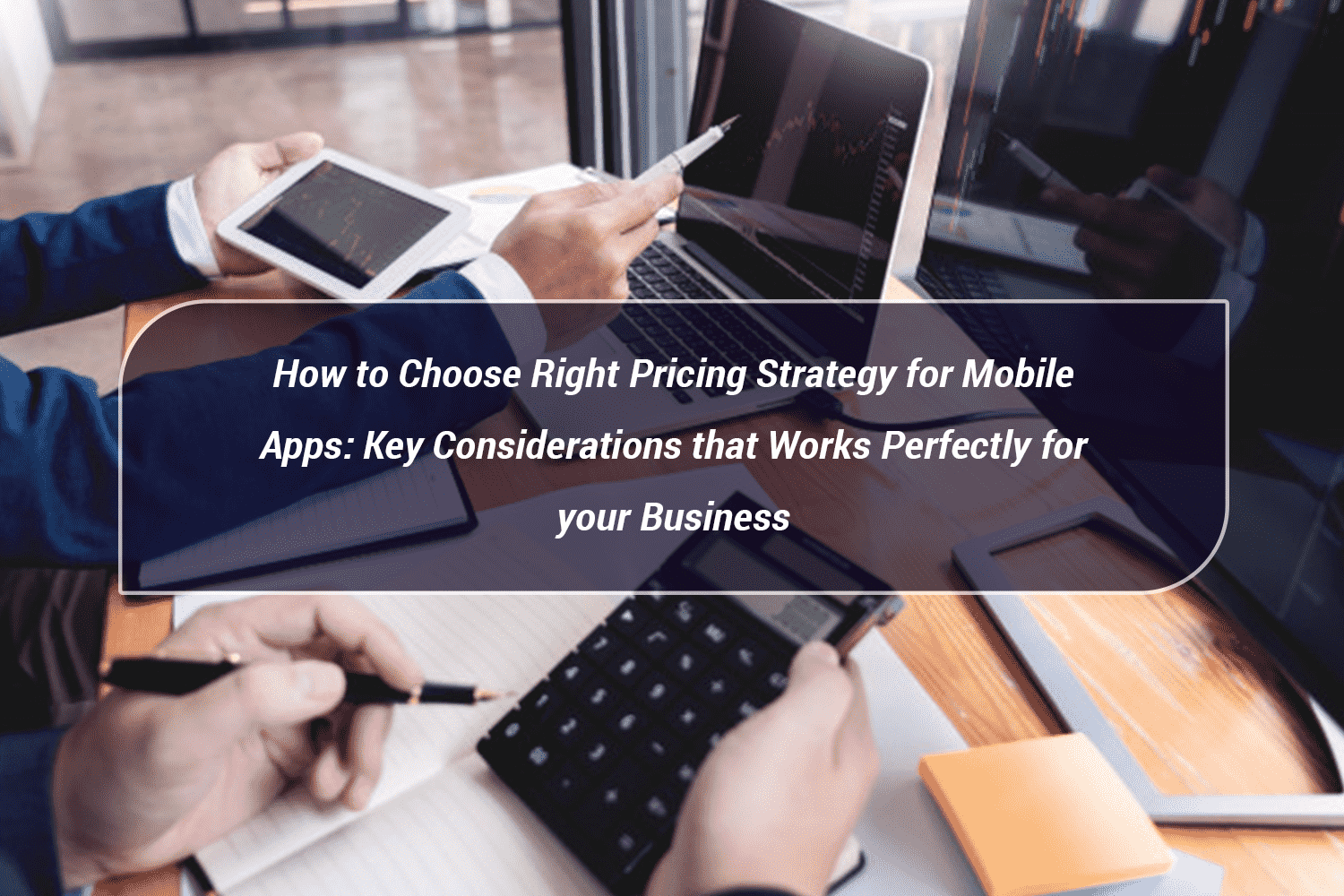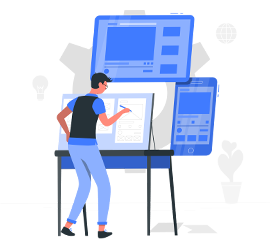August 3, 2020 | How to choose right Pricing Strategy for mobile apps: Key considerations that work perfectly for your Business

In this competitive world, the digital universe deciding about the right product price can be highly challenging and can involve an array of considerations
Mobile app pricing is one of the difficult to strategize and important parts of mobile app development and it is necessary to utilize the exact pricing strategy if you want your app to be marked on the app store. There are several factors to consider when choosing the right pricing strategy for your mobile app.
In a survey, it found that higher than 30% of the traffic arises from mobile devices and smartphones, and hence it is essential to choose the right pricing plan. The market forecast is that the global app revenue will rise to $101.1 billion in 2020. In this piece, we’ll look at the various pricing strategies for mobile apps and what you need to know to make the right decision for your app.
Let’s dive in.
What is the pricing strategy?
Pricing strategy is the method through which you make money from the app to maximize your profit and revenue. A pricing strategy refers to a methodology to determine the ideal or appropriate price of a product that at the same time avoids the two extremes of overpricing and underpricing. Various types of mobile app pricing models are followed in the market these days. In this blog, we will provide you the information regarding the most popular pricing models that are widely used and the correct way to select the mobile app pricing model. Pricing strategy is crucial to ensure compatible business conversion, sales, and marketing output.
How to choose your pricing model?
Just because you think it is the best pricing strategy and can help you make huge money then don’t force-fit any particular strategy. Firstly consider the below factors while choosing the right pricing model for your mobile app to maximizes your profit and revenue.
Before we talk about pricing strategies, let’s review an important pricing concept that will apply regardless of what strategies you use
- Firstly, app development purposes should be well analyzed.
- Identify the target audience. Are you willing to cater to a large user base or a niche market?
- The cost of creating a mobile application should be well known.
- It is important to know and understand the purpose behind the app development. Look whether you want to reach a large user base or target a smaller niche market.
- Analyse the cost of building the mobile app and what needs to be done to make a profit.
- Look for the competitor’s work. If there is an alternative for the low price point, you can opt for them — as the main objective of the business is to stay ahead of the competitors and earn profits.
- For achieving profits and accomplishing goals proper understanding of the marketing campaigns and business flow should be there.
- To be different from the crowd, proper market analysis plays a vital role. By analyzing competitors’ strategy in the market one can identify that the prices should be low or high.
If you want to offer freemium apps, you should focus more on providing valuable features and functionality to your customers. Users looking for more storage, backup, or line items in freemium apps. They don’t mind paying one-time subscription fees for value-added features and functionalities.
Pricing Strategies that can be used for Mobile App:
So now comes the hard part.
There is some serious revenue to be gained in the app market, but what is the best approach to monetizing your app? How do you know which pricing strategy do you choose?
Think about apps as you would any other product. They all follow the same laws of supply and demand. The right price is whatever price people are willing to pay. You have to play for the market. The wrong price could break dealings before the download even happens. Potential customers could be turned off by what they perceive to be a shocking cost, or they might delete an app they’ve downloaded after receiving too many pop-ups or simply not getting their money’s worth.
Therefore, while deciding on the app pricing strategy focus should be over:
- Define the value proposition that you are offering.
- Ensure that the offerings possess a greater value than those offered by the competitors.
- And the analysis of the other available apps should also be there.
Here we have discussed some of the best strategies to adopt within the mobile app. After going through it, you will get to know the impact of different prices on clients. At the end of the day, you have to consider many different factors before making your choice, including:
- Analyzing Consumer Behaviour and Psychology
- Design a product that users Desire
- Test the product at a variety of prices
- Market and Competitor Analysis
- Price should be feasible for the customers
Types of Mobile Pricing Strategies
-
Freemium Model
In this pricing model, the application can be freely downloaded and installed. Though, to use extra features, subscriptions, or to access the additional content available within the application the customer can make payment for that. A freemium app can perform well or not well, depending on how it’s positioned. Some people expect a free app to have full functionality and are disappointed when their access is limited. With the freemium pricing model, the app is free to download, but there are additional tiers, features, etc within the app that users can choose to pay for. From in-app purchases more money can be earned in the form of paid subscriptions, paid ad removal, virtual currency for example in games like Subway Surfer, Candy Crush life can be purchased.
There are three main types of freemium apps:
- Users download the app for free but must pay to move up in levels, access premium features, get boosters (e.g. extra lives), or use the in-app currency. These are all common in gaming apps.
- The app comes with all features and functionalities for free, but for a limited time. After that, the user must pay to continue using the app as they have been.
- The app is free and contains ads, but the user has the option to pay a one-time fee to have the ads removed.
-
Premium Model
These apps are a mixture of paid and freemium models, where users are requested to pay for the app but have the opportunity to unlock extra features by paying extra. Premium is not yet a powerful pricing strategy, but it has the potential to open new revenue brooks. Applications following this model are a divine mixture of freemium and paid models. In this model, initially, users have to pay for installing the application but also have an opportunity to get access to additional features and content by paying the extra sum. Though, this strategy is not widely used but does possess the potential for generating great revenue streams. The premium may work well for music apps, social networking, and navigation apps. This pricing approach is successful only if you provide reasons to the users to make a purchase, it helps to generate revenue.
Advantage:
- Provides ongoing benefits for app developers
- Pushes developers to be productive
- Find new methods to encourage users to spend more money.
-
Free Model
The name itself defines that an application following a free model can easily be downloaded without paying any amount. The apps are completely free to download in the app store, where their main source of income comes from advertisements.
Generally, free applications are selected by those companies which focus on over-designing products or services to increase their proposition. Moreover, these applications can be used as a tool for customer engagement and providing relevant information.
Advantages:
- The number of downloads is more.
- Expectations of the users from free applications are less.
- This model is picked by most of the new app users
-
Paid Model:
More than 2 lakhs of apps are paid on the Google Play Store as opposed to 2,475,000 that are free. So, this model is a major critical path to earning money on apps. Paid apps require some fee that needs to be paid once for downloading the app. But these apps have seen a huge decrease in popularity over the years, due to the big boost in several free and freemium apps. As per the experts, paid is still a fruitful pricing strategy for certain apps but it is the least effective strategy purchasing the app for one time is a common pricing approach. The effort is particularly fierce when there is a potential free app with similar functionality possible already.
Advantages:
- Business with lots of customers, like good brand popularity.
- Payments have to be made before the user undergoes the app, which means revenue is not reliant on the user’s interaction with the app. Still, such interactions can affect reviews & ratings in the extended run.
Conclusion
It’s more challenging than ever for apps to break in, stand out, and remain relevant. Take the product pricing strategy seriously, as it is one of the important stages of mobile app development. Keeping up with trends and user expectations is the number one priority for ensuring your app gets in front of the eyes of thousands. You choose the pricing strategy that reflects the value of the app, meets market expectations and achieves your business goals. Remember that the launch time is the best time to attract maximum customers, and you should not charge atrociously. You should price it reasonably and at the same time take advantage of the current market price.

 .Net
.Net Vue.js
Vue.js Twilio
Twilio Postgre
SQL
Postgre
SQL PHP
PHP React.js
React.js Bootstarp
Bootstarp MySql
MySql Laravel
Laravel Woo
Commerce
Woo
Commerce Firebase
Firebase SQL
Server
SQL
Server Angular
Angular Python
Python ChatBot
ChatBot Wordpress
Wordpress Node.js
Node.js Full
Stack
Full
Stack MongoDB
MongoDB Drupal
Drupal





















